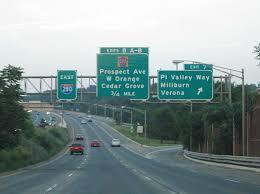COMMON THREADS
There may not have been as many mission statement songs on the charts as during the summer of 1967. One, Scott McKenzie’s San Francisco, was tied to a specific place and time. Others, while a bit more generic, caught the zeitgeist flush: Get Together, which floated around the bottom of the Billboard Hot 100, then reappeared as a top ten hit in 1969, and All You Need Is Love, the template for Imagine.
A more subtle anthem from that summer was the Monkees’ Pleasant Valley Sunday, with a guitar sound borrowed from the Beatles’ Revolver album and lyrics that rejected consumerism and suburbia. Carole King and Gerry Goffin, who wrote the song, lived on Pleasant Valley Way in West Orange, NJ and whether the lyrics are a diary or a dramatization, the street truly featured “rows of houses that are all the same,” although it’s been awhile since I’ve driven through it..
Pleasant Valley Way exits off I-280, which connects I-80 to the north with the New Jersey Turnpike 18 miles away, and marks about the last spot where people worry about their lawns before the highway cuts through urban East Orange and Newark. In the early sixties, Janis Ian and her family were among the diminishing number of white people living in East Orange. Her Society’s Child, also from the summer of 1967, felt and sounded like a Shangri-Las song; teenage angst about parents who disapprove of boyfriends. For the Shangri-Las is was a wiseass who drove motorcycles. Janis, on the other hand, was facing down her parents and classmates for dating a black kid.
The song starts defiantly, but eventually the singer gives in to the taunts and smirks, and tells her boyfriend in the last line, “I won’t see you anymore baby” and then, hopefully, gets away from her parents and East Orange, maybe to keep an appointment with a man from the motor trade.
Society’s Child entered the Billboard top 20 on July 17, the same day the Newark Riots more or less ended and the National Guard tanks turned around and rumbled back to Fort Dix. It’s been said that one of many contributing factors to the riots was the construction of I-280, as rows of houses that were not the same, many of them historic Victorians, and commercial buildings were demolished. Newark, the most populous city in New Jersey, is only about 26 square miles, much of that airport, trucking depots and salt marshes. Building the highway, which spans ten lanes across at some points, squeezed its residents further until they were practically living on top of each other.
Living some 25 miles from the riots, my friends and I agreed to not ride our bikes anywhere near Passaic Street, which we saw as the dividing line that set the boundary for the “black section” of town. My father, a fireman, said orders from above were that if a house caught fire and black people began to throw bricks at the firemen, they were to let it burn.
The lyrics to Pleasant Valley Sunday were kind of cartoony, but I understood where the Monkees were coming from. To me, suburbia meant safety. It was home. With time, we began to ride our bikes past Passaic Street again, into the neighborhoods where the houses were a little more rundown, the lawns thinner. There were nasty dogs, who barked and jerked their chains when we rode past. In September, I’d begin middle school, sharing classes with more black kids than ever before. Nobody threw any bricks. And nobody dated anyone from the other side of Passaic Street.